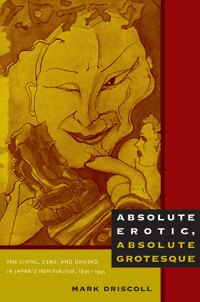
Absolute erotic, absolute grotesque : the living, dead, and undead in Japan’s imperialism, 1895-1945 PDF
Preview Absolute erotic, absolute grotesque : the living, dead, and undead in Japan’s imperialism, 1895-1945
Absolute Erotic, Absolute GrotEsquE Mark Driscoll Absolute Erotic, Absolute GrotEsquE the living, DeAD, AnD unDeAD in JApAn’s imperiAlism, 1895–1945 Duke university press Durham and london 2010 © 2010 Duke University Press All rights reserved Printed in the United States of America on acid- free paper ♾ Designed by Heather Hensley Typeset in Charis by Tseng Information Systems, Inc. Library of Congress Cataloging- in- Publication Data appear on the last printed page of this book. From Diane Contents Preface ix Acknowledgments xvii Abbreviations xxi Introduction 1 Part I Biopolitics 1. Cool(ie) Japan 25 2. Peripheral Pimps 57 3. Empire in Hysterics 81 4. Stubborn Farmers and Grotesqued Korea 101 Intertext I. A Korean is being beaten; I, a Japanese colonizer, am being beaten 119 Part II neuropolitics 5. All That’s Solid Melts into Modern Girls and Boys 135 6. Revolutionary Pornography and the Declining Rate of Pleasure 161 Intertext II. Neuropolitics Sprouts Fangs 203 Part III necropolitics 7. The Opiate of the (Chinese) People 227 8. Japanese Lessons 263 Conclusion: Bare Labor and the Empire of the Living Dead 295 Notes 315 Bibliography 327 Index 345 PrefaCe This book describes how Japan rose to be a world power in a few short decades. The dominant way of narrating that rise tends to focus on centers of power, whether the center is the supposed Euro- American birthplace of modern technoscience and Enlightenment reason or is understood to be Japan’s westernized metropole, Tokyo. Against this hegemonic assumption that advanced conceptual and technical forms of Euro- American and metropolitan origin are the sole causes of mod- ern development, subalternist postcolonial studies and Marxism—the two theoretical approaches privileged here—recommend that critical attention be redirected to human life and labor, especially that inhabit- ing the margins and peripheries far away from centers of power. Therein the ontological energy of life and the surpluses stolen from labor (by capital) can be clearly glimpsed as the engines driving imperial expan- sion. In this book marginal life and peripheral labor spawned in Japan’s peripheries in Korea and China will move out of the historiographical shadows to become starring dramatis personae. As the fleshly container of life and labor is the body, working bodies, desiring bodies, addicted bodies, and dying bodies are offered up as evidence for what I call the peripheral a priori: the spatiotemporal prioritizing of peripheral mar- ginalia as the primary agents of culturo- economic change, what D. K. Fieldhouse depicted as the “metropolitan dog wagged by the tail” of the colonial periphery (cited in Uchida J. 2005, 38). In this study of Japan’s imperialism, the peripheral tails wagging the dog of the imperial center are Chinese coolies, Japanese pimps working in China’s treaty ports, trafficked Japanese women, and poor Korean tenant farmers— the bodies supplying the vital energy and laboring surplus that mattered (to) Japan’s imperialism. The importance of the colonial periphery for empire was a given for
